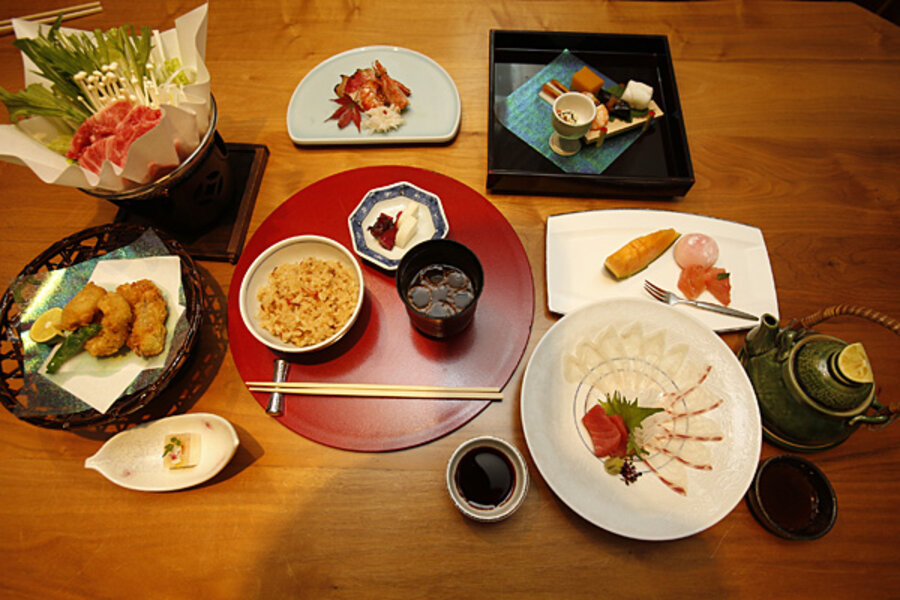Can UNESCO save traditional Japanese cuisine?
Loading...
| Tokyo
This week, the UN will decide whether to award traditional Japanese cuisine, called Washoku, distinction as an intangible cultural asset at a meeting in Azerbaijan.
From a global standpoint, the benefits of UNESCO recognition are clear. Aside from French cusine, Washoku would become the only national cuisine to be named a cultural asset. (Mexico’s traditional dishes are listed, as well as individual food-related elements from certain countries, like Viennese coffeehouse culture in Austria or the Mediterranean diet in Greece.) Globally, it gives an extra sense of legitimacy to Japanese food’s rising popularity over the past two decades at a time when the government is looking to boost exports – the Abe administration wants to double Japanese exports by 2020.
But domestically, those pushing for “intangible asset” status are hoping it will serve as a counterweight to the increased Westernization of the Japanese diet, a phenomenon that is having both dietary and large-scale economic consequences.
A changing Japanese diet
So, what qualifies as an intangible cultural asset? Examples include folk dances, music, and certain types of craftwork, like Chinese calligraphy and Iranian carpet weaving. UNESCO describes them as “cultural elements that concerned communities and countries consider require urgent measures to keep them alive.”
In Japan, many believe, that last part may be key for Washoku. The typical Japanese diet, which used to revolve mainly around rice, fish, and pickled vegetables, has been heavily influenced by the introduction of fast-food restaurants from the West and prepackaged convenience foods from other parts of Asia, including China and Taiwan. On the dietary end, that means a lot more meat, bread, and oil. On the economic end, it means a heavier dependence on foreign imports and a lower level of self-sufficiency. According to the Ministry of Agriculture, Japan produces only about 40 percent of what it needs to feed its citizens, which is very low relative to other developed countries. The United Kingdom, by contrast, produces about 70 percent of the calories it needs; France produces 120 percent.
“Our food culture has quite changed over the years,” says Toshiharu Shimowatari, a professor in the Department of Food and Business at Nihon University, near Tokyo. “In general, we started eating more meat, which means we needed more crops for feed. These are mostly corn and soybeans, which we do not produce, so we have to import them. At the same time, imports from Asia have grown in the form of prepackaged, processed food. The demand for it has grown, and other countries can produce it a lot cheaper” than Japan can.
The Japanese government would like to increase the nation’s food self-sufficiency rate to 50 percent, say officials at the Ministry of Agriculture. Mr. Simowatari sees that goal as unrealistic. “Impossible,” he says. “Even a 1 percent increase is very difficult.” He notes that one of the ideas touted by the ministry is increasing rice consumption, which is at odds with dietary trends: Rice consumption has decreased by 17 percent over the past decade and a half.
Cuisine as culture
Yoshiro Murata, one of Japan’s most celebrated chefs and one of the architects of the UNESCO bid, is less concerned with the evolution of Japanese tastes. It’s natural that food has diversity,” he says. “The history of all food is influenced by other cuisines. In the past, we have had movements like the sushi police,” in which a task force would certify sushi in other countries as authentically Japanese, or not. “We shouldn’t be like that. Japanese cuisine is like a young tree. Lots of leaves, but we don’t have to cut them down right now. That will help that grow into a big tree. Maybe then, after a while, we can bring in experts to define what makes up Japanese cuisine and what doesn’t.”
Where UNESCO recognition will help, Mr. Murata thinks, is in preserving cooking techniques and dining traditions among a Japanese public that is becoming more accustomed to eating out, often alone. Food education, called Shokuiku in Japan, is a major concern: Passed in 2005, the Basic Law of Shokuiku established various food and nutrition education programs in Japan’s public schools.
Furthermore, Murata says, it could help establish Washoku as an academic field, prompting a certification program for Japanese chefs and institutions as the Culinary Institute of America (CIA) does for US chefs. He thinks that other nations should think about what parts of their own cuisine to preserve as cultural heritage. “In America, everyone eats turkey on Thanksgiving. That’s very unique!” he laughs. “Taste-wise, I would give the upper hand to chicken, but it’s part of your traditions. Maybe that’s your cultural asset.”
It’s unusual for the UN to deny a UNESCO bid at this stage, but there are headwinds. The reputation of Japanese food fallen in recent months. Several Japanese hotels and restaurants recently admitted to mislabeling inferior food products – things like wagyu beef and Shiba shrimp – and passing them off as premium-branded fare, a scandal that has rocked the high-end Japanese food world. Furthermore, the nation is still facing a public relations fallout, both domestically and abroad, from the Fuskushima nuclear disaster. Though government officials insist that fish and crops from the affected regions are safe, many remain unconvinced. Japan’s fish exports fell 25 percent in 2012, and South Korea recently banned fish exports from the Fukushima coast.
Reporting for this story was made possible through a fellowship with the Foreign Press Center of Japan (FPCJ).








